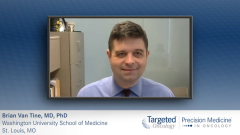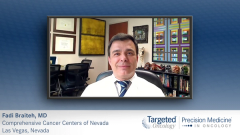
Sequencing Resectable GIST
Fadi Braiteh, MD, discusses sequencing in patients with resectable and unresectable gastrointestinal stromal tumors (GISTs) and explains the impact on treatment considerations.
Brian Van Tine, MD, PhD: I think we should look at GIST [gastrointestinal stromal tumor] as a journey. If a patient has a resectable GIST, do you sequence it?
Fadi Braiteh, MD: There are resectable GIST cases and unresectable GIST cases. There are those patients who are not candidates for adjuvant treatment because they meet criteria based on location. Although it’s not on the label of the drug, where we even consider neoadjuvant treatment, it’s not really to shrink the tumor and secure an R0 resection, which is often the case in neoadjuvant treatment. But like we do in breast cancer, treating neoadjuvantly, it’s really a predictor of the outcome and the prognosis is based on the quality of response.
Talking to my colleagues in surgical oncology, they recognize that even a couple of weeks of treatment can help reduce the incidence of hemorrhage, or amount of blood, etc. The standard today is, if the patient is resected, to give adjuvant treatment. The only drug that has been used is imatinib. I’ve not changed my practice, and I don’t think there are strong data to say we should use any of the other agents in the adjuvant setting yet, although it’s very tempting. It’s important to know the driver of the cancer. This is especially important for dosing, at least. If it’s a c-KIT mutation, since we sometimes adjust the dose based on exon 9 versus exon 11, would that be the same case in the adjuvant setting?
Adjuvant treatment is already difficult. I always say the compliance of our patients with imatinib, for example, in metastatic disease is much better than in the adjuvant setting. It’s the same patient population. In CML [chronic myeloid leukemia], the compliance is amazing. But in the adjuvant setting it becomes tricky. Patients are less likely to complete 3 years of therapy. They barely complete 1 year. So for the time being, molecular profiling for a resectable GIST, again, only if the patient is at high risk of recurrence. And if I’m treating the patient with adjuvant therapy, I need to know how to adjust the treatment and be ready to do so.
Brian Van Tine, MD, PhD: I think from a tertiary referral center, it’s very interesting that 10% of alternative mutations—BRAF, NTRK, NF1, etc—if we see those, our percentage is actually much higher. And so, we’re not about to commit an NTRK fusion-driven GIST to 3 years of imatinib. We’re in the habit of sequencing so that we know what we’re dealing with. And because we see so many alternative mutations, it becomes kind of a different approach. It’s really easy to see what GIST at this point is and to know what the mutations are.
Do you manage exon 9 differently? I don’t think the data are there for that. The trial took all these patients evenly.
Fadi Braiteh, MD: Absolutely. And in fact, my question to you from a community setting is, if someone does profiling and doesn’t see a c-KIT mutation, and if it’s a PDGFRA mutation, you still think imatinib will have an effect. But if you see it’s one of the other of mutations that is not addressed by a TKI [tyrosine kinase inhibitor] like imatinib—you mentioned NTRK—is this someone who otherwise meets the criteria for adjuvant imatinib?
Brian Van Tine, MD, PhD: Like a NTRK fusion, we probably wouldn’t. The more common question that comes up is what do we do if we identify D842V PDGFRA mutations? We clearly don’t do adjuvant therapy, and that turns out to be more common among the exceptions we see. I think it’s important, before committing somebody to 3 years of therapy, that they’re not KIT wild-type. Committing somebody to 3 years of therapy is a big deal. Imatinib, compared to ifosfamide, seems rather low in terms of the [adverse] effect profile. But it is still a real drug. And so, we have to be careful in terms of what we’re doing. In this era of precision medicine, we have the ability to have as much information on our side. It no longer takes 3 months to get sequencing back. I think we’re able to approach this in a precision medicine type of way.
Transcript edited for clarity.















































